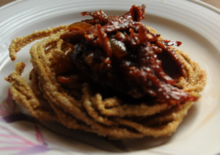
Malaysian cuisine consists of cooking traditions and practices found in Malaysia, and reflects the multi-ethnic makeup of its population. The vast majority of Malaysia's population can roughly be divided among three major ethnic groups: Malays, Chinese and Indians. The remainder consists of the indigenous peoples of Sabah and Sarawak in Malaysian Borneo, the Orang Asli of Peninsular Malaysia, the Peranakan and Eurasian creole communities, as well as a significant number of foreign workers and expatriates.

Laksa is a spicy noodle dish popular in Southeast Asia. Laksa consists of various types of noodles, most commonly thick rice noodles, with toppings such as chicken, prawn or fish. Most variations of laksa are prepared with a rich and spicy coconut soup or a broth seasoned with sour asam. Originating from Peranakan culture, Laksa is commonly served in Indonesia, Malaysia, Singapore, and southern Thailand.

Malay cuisine is the traditional food of the ethnic Malays of Southeast Asia, residing in modern-day Malaysia, Indonesia, Singapore, Brunei, Southern Thailand and the Philippines as well as Cocos Islands, Christmas Island, Sri Lanka and South Africa.

Hokkien mee is a Southeast Asian dish that has its origins in the cuisine of China's Fujian (Hokkien) province. There are three distinct types of Hokkien mee found in Malaysia and Singapore.

Otak-otak, which literally translates as "brains" in Indonesian and Malay languages, is a Southeast Asian fish cake made of ground fish meat mixed with spices and wrapped into leaf parcels. Otak-otak is traditionally served fresh, encased within the leaf parcel it is cooked in, and can be eaten solely as a snack or with steamed rice as part of a meal.

Singaporean cuisine derived from several ethnic groups which have developed through centuries of political, economic, and social changes of this cosmopolitan city-state.

Lekor, keropok lekor or fish sausage is a traditional Malay fish cracker snack originating from the state of Terengganu, Malaysia. It is made from fish and sago flour and seasoned with salt and sugar. It is slightly greyish in colour and gives off a fishy taste and smell which becomes more prominent as it cools down after frying. The word lekor is said to be derived from a Terengganu Malay word meaning "to roll".

Malaysian Chinese cuisine is derived from the culinary traditions of Chinese Malaysian immigrants and their descendants, who have adapted or modified their culinary traditions under the influence of Malaysian culture as well as immigration patterns of Chinese to Malaysia. Because the vast majority of Chinese Malaysians are descendants of immigrants from southern China, Malaysian Chinese cuisine is predominantly based on an eclectic repertoire of dishes with roots from Fujian, Cantonese, Hakka and Teochew cuisines.

Banmian or pan mee is a popular Chinese noodle dish, consisting of handmade noodles served in soup. Other types of handmade noodles include youmian, or mee hoon kueh.

Penang cuisine is the cuisine of the multicultural society of Penang, Malaysia. Most of these cuisine are sold at road-side stalls, known as "hawker food" and colloquially as "muckan carts". Local Penangites typically find these hawker fares cheaper and easier to eat out at due to the ubiquitousness of the hawker stalls and that they are open for much of the day and night. Penang island. On February 22, 2013, Penang was ranked by CNN Travel as one of the top ten street food cities in Asia. Penang has also been voted by Lonely Planet as the top culinary destination in 2014.

A curry puff is a snack of Maritime Southeast Asian origin. It is a small pie consisting of curry with chicken and potatoes in a deep-fried or baked pastry shell. The curry is quite thick to prevent it from oozing out of the snack.

Sungai Siput (U) is a town, mukim in Kuala Kangsar District, Perak, Malaysia, covering 155.141 hectares, 61.5% of the total area of Kuala Kangsar. It is located about 25 km from state capital, Ipoh and 20 km from royal town of Kuala Kangsar. Sungai Siput falls under the management of the Kuala Kangsar Municipal Council.
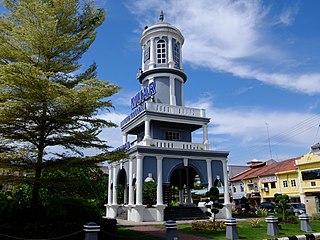
Muar or Bandar Maharani, is a historical town and the capital of Muar District, Johor, Malaysia. It is one of the most popular tourist attractions in Malaysia to be visited and explored for its food, coffee and historical prewar buildings. It was recently declared as the royal town of Johor by Sultan Ibrahim Sultan Iskandar and is the fourth largest city in Johor. It is the main and biggest town of the bigger entity region or area of the same name, Muar which is sub-divided into the Muar district and the new Tangkak district, which was upgraded into a full-fledged district from the Tangkak sub-district earlier. Muar district as the only district covering the whole area formerly borders Malacca in the northern part. Upon the upgrading of Tangkak district, the Muar district now covers only the area south of Sungai Muar, whilst the northern area beyond the river is in within Tangkak district. However, both divided administrative districts are still collectively and fondly called and referred to as the region or area of Muar as a whole by their residents and outsiders. Currently, the new township of Muar is located in the Bakri area.
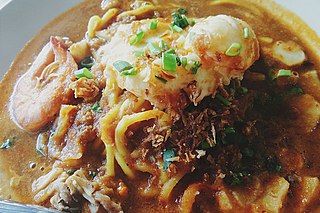
Mee Bandung Muar, or simply Mee bandung, is a traditional Malaysian cuisine which is originated in Muar, Johor, Malaysia.

Malaysian Indian cuisine, or the cooking of the ethnic Indian communities in Malaysia consists of adaptations of authentic dishes from India, as well as original creations inspired by the diverse food culture of Malaysia. Because the vast majority of Malaysia's Indian community are of South Indian descent, and are mostly ethnic Tamils who are descendants of immigrants from a historical region which consists of the modern Indian state of Tamil Nadu and Sri Lanka's Northern Province, much of Malaysian Indian cuisine is predominantly South Indian inspired in character and taste. A typical Malaysian Indian dish is likely to be redolent with curry leaves, whole and powdered spice, and contains fresh coconut in various forms. Ghee is still widely used for cooking, although vegetable oils and refined palm oils are now commonplace in home kitchens. Before a meal it is customary to wash hands as cutlery is often not used while eating, with the exception of a serving spoon for each respective dish.
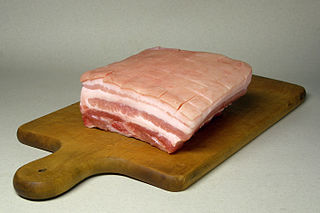
Pork rind is the culinary term for the skin of a pig. It can be used in many different ways.
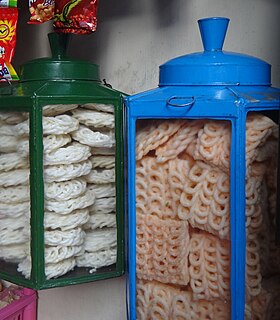
Krupuk (Javanese), kerupuk (Indonesian), keropok (Malay), kroepoek (Dutch) or kropek (Tagalog) is a deep fried cracker made from starch and other ingredients that serve as flavouring. They are a popular snack in maritime Southeast Asia, and is most closely associated with the culinary traditions of Indonesia, in particular Javanese cuisine. It is an ubiquitous staple in its country of origin, and later spread to other countries either via the migration of diaspora populations or exports.

In the past, Phuket was one of Thailand’s commercial ports which traded with other countries. These cultural influences are reflected in the cuisine and local foods. Phuket cuisine and local food is the combination of many cultural food habits, whether they be Chinese, Malay or Thai. Some Phuket local food tastes sweet, such as Chinese Hakka cuisine, but it can also be spicy, such as in Thai cuisine and Malay cuisine.

Sarawakian cuisine is a regional cuisine of Malaysia. Like the rest of Malaysian cuisine, Sarawak food is based on staples such as rice. There is also a great variety of other ingredients and food preparations due to the influence of the state's varied geography and indigenous cultures quite distinct from the regional cuisines of the Peninsular Malaysia. Sarawak is famous for its multi-ethnic population. As the homeland of many unique communities, Sarawak has a variety of cuisines rarely found elsewhere in Malaysia. The uniqueness of Sarawak well depends on its ethnic groups. Every native group in Sarawak has their own lifestyle, traditions, cultures and also foods. Sarawak cuisine is less spicy and has a subtle in taste. It uses fresh seafood and natural herbs like turmeric, lemongrass, ginger, lime and tapioca leaves. These ingredients are not only easily available, but also add a hint of aroma, texture and freshness to the delicacies. Food is one of the most cultural identities for native groups in Sarawak with each ethnic group having their own delicacies. Among the Iban, popular foods include tubu (stems), tuak and pansuh. The Malay have bubur pedas (porridge) and kek lapis Sarawak ; the Bidayuh have asam siok and sup ponas Bidayuh. The Melanau make tebaloi, sagu and umai and the Orang Ulu are known for garam barrio, kikid (broth), tengayen, and urum giruq (pudding).
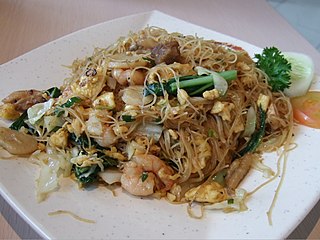
Bihun goreng, bee hoon goreng or mee hoon goreng refers to a dish of fried noodles cooked with rice vermicelli in both the Indonesian and Malay languages. In certain countries, such as Singapore, the term goreng is occasionally substituted with its English equivalent for the name of the dish.
